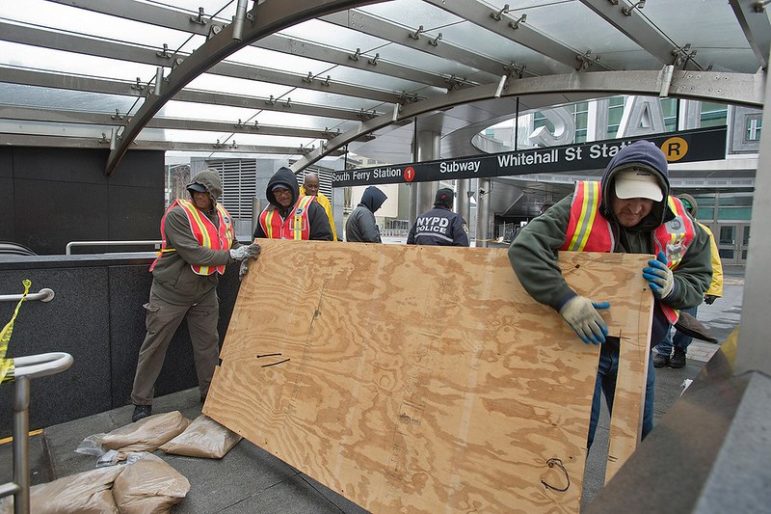The city’s transit system faced a different threat this week than the coastal storm surges it endured during Hurricane Sandy: A sewer system overwhelmed by increasing rain, even at higher elevations.

Metropolitan Transportation Authority/Patrick Cashin
MTA crews making Sandy-related repairs at the Whitehall St. Station in 2017.On Wednesday night, record rainfall and flash flooding inundated New York City with water, leaving nine people dead and leading to a near complete shutdown of the subway system.
Viral videos showed water gushing through subway platforms, a fire on the track in Union Square, and rats floundering in the flood waters—putting a spotlight on the vulnerability of the city’s transit system. At least six trains needed to be evacuated, and riders were stuck underground in trains for over an hour.
The remnants of Hurricane Ida hit New York just a week after Tropical Storm Henri set a record for rainfall in Central Park—one that was broken again Wednesday night—and nearly nine years after Superstorm Sandy caused $5 billion of damage to the subway system.
On Thursday morning, government officials acknowledged that the century-old MTA infrastructure is not prepared to deal with flash flooding, which occurs when the sewer system becomes overwhelmed, causing water to fill streets and pour into subway entrances. These floods are different from storm surges, which happen when sea levels rise suddenly, as with Superstorm Sandy, and affect coastal areas.
“We prepared after Sandy to deal with resiliency along the coastline,” said Gov. Kathy Hochul in a press conference Thursday afternoon. “What we don’t have is enough resiliency in our city streets, and what we’re talking about is the fact that there’s too many drainage systems that are incapable of handling that volume of water.”
The governor said she will conduct an “after-action report” on the state and the MTA’s preparedness and response to the storm.
“What did we know and when do we know what we had, what information did we have? Are there any intelligence failures in terms of our preparedness?” she said Thursday.
“And the question is, should we have shutdown subways earlier?” she added, but said doing so “is not an option” as it would have risked trapping people who were already on trains underground. “But I want to assess why we don’t stop people from—new passengers—from going down the stairs into them. It all should be about evacuation, not bringing new people into the system at the time.”
In recent years, the MTA has installed at least 70 Kevlar “flex gates” that are able to seal off subway entrances and hold back up to 14 feet of water. But the stations prioritized for those devices are in flood zones, near the coastline, which doesn’t protect against flash flooding elsewhere in the system.
There’s also a technical issue: deploying the gates takes several minutes, making them less effective in a flash flood situation, an MTA spokesperson explained.
At Thursday’s post-storm briefing, Mayor Bill de Blasio discussed the urgency of addressing the flood risk at higher elevations, not just along the waterfront areas that have been the focus of post-Sandy resiliency efforts.
“It’s not just coastal resiliency, it’s now about vulnerability of higher elevations where the drainage infrastructure is insufficient to withstand these kinds of extremes,” he said. “Remember, the subway is not a submarine, there’s water coming from directions and all penetrations, we have to plan for it.”
The solution is two-fold and involves city and state cooperation, explained Dr. Klaus Hans Jacob, a seismologist at Columbia University’s Earth Institute. He said the city needs to mitigate overflows of the sewer system that causes water to collect on the streets and pour into stations, and the MTA needs to come up with solutions to block the subway entrances when that does happens.
He noted that one way to address street flooding could be to elevate the entrances at stations—creating a levee of sorts—so a rider would walk up a step or two before going underground. This structure has been implemented at a stop in Park Slope, he said.
But implementing these MTA improvements would involve major financial investment. The transit agency has been under dire monetary straits in recent years: Congestion pricing, approved by the state more than two years ago as a means to raise revenue for the MTA, still isn’t up and running yet.
“There’s a big dollar sign around this,” Jacob added. “The MTA is essentially at the mercy of the governor and the legislature in Albany, and they have to allow the MTA budget to be in shape so they address it.”
MTA Acting Chairman Janno Lieber echoed the need for the agency to make the shift in an interview with Fox 5 Thursday morning.
“We’re going to expand the resiliency efforts to look at these higher ground areas, higher elevation areas, in tandem with the city of New York which operates the street level drainage and sewer system. We have to attack that now in this era of climate change,” he said.
This investment becomes even more dire as the frequency and intensity of flash flood events increases. “Climate Change in big capital letters [is] written on the subway walls,” said Jacob.
Scientists on the Intergovernmental Panel on Climate Change released a report last month that warned that urban areas will experience more incidents of “flooding from heavy precipitation events” in the future.
The report also noted that it is essentially inevitable that global temperatures will reach 1.5 degrees Celsius above pre-industrial levels in the next 20 years—and that immediate action needs to be taken to limit the rise to only that amount. Each .5 degree beyond that would mean more frequent and intense weather events.
“As the oceans get warmer and the atmosphere gets warmer, there is more moisture in the air, and then it confronts a cold front, and that additional moisture comes down like cats and dogs,” said Jacob.
Gov. Hochul also acknowledged the immediacy needed in preparing the city’s infrastructure for the next catastrophic event.
“This isn’t going to happen every 500 years,” she said. “This may happen again next week.”
Liz Donovan is a Report for America corps member.








